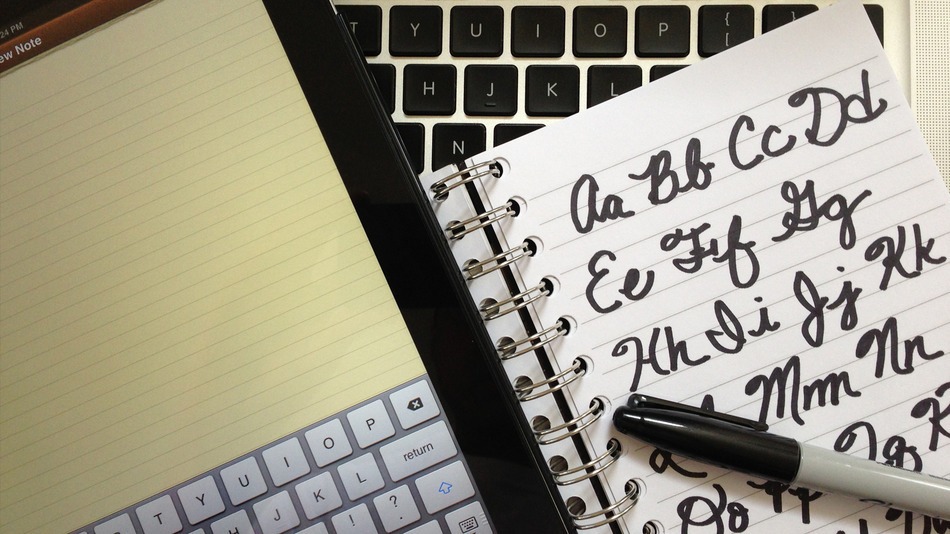TECHNOLOGY: Technology progresses while people in the present retreat from tradition.
By Amy Wang, Opinions Editor
Cursive has been kicked to the curb. That’s right—those curly letters your third grade teacher scared you into learning because “you would use them forever” has met its end. Maybe forever isn’t that long after all.
The new Common Core educational standards cut cursive from grades K-12th; however, the classic, curly letters are not dead just yet. California and six other states are keeping cursive in their curriculum (please try to imagine tiny third graders raising their fists at the system right now; it makes this debate much more interesting.) Advocates of cursive argue that if schools stop teaching cursive, we will lose the ability to interpret valuable, old documents, such as the Constitution.
On the other hand, critics of cursive claim that the form of writing is obsolete in today’s digitally-obsessed society, whereas the mastery of computer keyboarding is more important than cursive. Let’s be honest; cursive is barely remembered or used except for signatures. The argument does not stop there; it’s a constant back-and-forth banter, both sides with valid arguments. In the end, it all circles back to the classic “tradition versus technology” debate that never seems to end in our age of growing smartphones and shrinking laptops.
The removal of cursive is not the only move towards technology-based education. Educators everywhere are scrambling to find ways to get students excited about school, looking to social media and other technologically “hip” means to appeal to students.
Educators are so caught up on how to appeal to students that they seem to forget their job: teaching them. It’s understandable that they want to find the best ways to interest students, but passion or even an interest for education can’t be bought through cheap tricks on a screen. Teaching, whether it’s on a chalkboard or on a Smart Board, should still be teaching.
To be fair, technology is great. It provides opportunities to students that previously weren’t available. Online classes are life savers to credit-deficient students and interactive software programs have proven to make learning easier. But these results don’t call for a technology take-over.
Just because we have the means of typing does not mean we need to kick out previous forms of script. Cursive, as useless as it may seem to those who discarded all knowledge of the written form after the third grade, still proves handy—no pun intended—when it comes to quick note-taking or signatures. Cursive is not useless; it’s just scarce because people aren’t taking advantage of this useful ability.
There needs to be a balance between tradition and technology. Our books can be online and our notes can be on paper. Likewise, cursive and typing can be taught together. We don’t need to get rid of one to implement the other.
Yet the technology-versus-tradition argument is constantly painted as black and white. On one side is a world filled to the brim with technology, to the point where every aspect of life is associated with technology. Then there’s the other side, demanding that we stop this technology “brainwash” completely.
When we think of technology, the first thing that comes to our minds are smartphones, laptops, gaming consoles and tablets. But we forget that technology is much more than your Fruit Ninja high score. Technology puts the information of the world literally into the palms of our hands, an idea seemingly inconceivable until the introduction of the Internet and the smartphone. Technology allows us to live longer and stronger. Technology finds ways to breathe life back into a six-year-old diagnosed with leukemia or a mother in critical condition after a car crash.
Tradition is more connected to technology than we think. Tradition is what set the standards for science to begin with. Tradition is sending our kids to school in hopes that they’ll learn more about the world. Tradition passes customs from generation to generation, and it does not just die because technology develops. Tradition is curiosity, and curiosity is technology.
What we fail to remember during our constant debates about technology is that technology has always been advancing. The creation of the wheel, a device we consider basic today, was once a break-through—even more important than our precious iPhones. Technology will never stop advancing so long as humans are still curious, which will hopefully be forever.
But with the introduction and implementation of the wheel, humans did not stop using their legs. Just like how, even if we have typing, we don’t have to give up penmanship. Technology is an advancement, not a replacement, to today. We can change the way we communicate, share and research, but that does not mean we have to destroy all previous means. As Stephen Fry said, “Books are no more threatened by the Kindle than stairs by escalators.” Technology is no more than an aid to what we already have today.
Everyone seems to think that there’s only one way to move forward: by following the rules or by discarding all of them and making new ones. But why can’t there be both? Educational methods suddenly became a battle between tech-lovers and tradition-geeks, both sides screaming, “You’re either with me or against me!” while raising their choice of weapon, whether that be a keyboard or a pen.
We can let technology in without kicking tradition out. What we need is a balance and an understanding on both sides. The world is not black and white, and neither are humans, so why should our education be an ultimatum? Give us choices instead of a manual on how to be a student, and we will give you results.
Photo courtesy of mashable.com

